The Books of To-day and the Books of To-morrow, June 1905
ACADEMY NOTES.
No. 51 (‘Señor Manuel Garcia’).—The Hired Frock-coat.
No. 125 (‘Lamia’).—Leap Year. Lady proposing to her partner while sitting out at the Bachelors’ Fancy Dress Ball.
No. 182 (‘A Roman Triumph’).—Return of the Aston Villa team to Birmingham after the final tie.
No. 194 (‘The Morning of Sedgemoor’).—Back to the Land. City clerks sleeping in barn after haymaking.
No. 279 (‘The Invaders’).—March of the Raunds bootmakers.
No. 299 (‘Betrayed by the Moon’).—Baltic Fleet shooting torpedo-boat in mistake for trawler.
No. 302 (‘W. A. Bell. Esq.’).—‘Yes. I know I look queer. They promised to send back that collar in time, and it hasn’t come!’
No. 358 (‘Communal Sitting of the Burghers of Landsberg’).—The Bump Supper. The President of the Rowing Club obliges with a song.
No. 425 (‘Columba in exile welcomes the Wild Birds that cross the sea from Ireland’).—Feeding the ducks in St. James’s Park in the Middle Ages.
No. 429 (‘Upward to Liberty and Life: Excelsior’).—The Last ’Bus. Conductor gathering in belated fare. ‘Just in time, sir!’
No. 432 (‘Alone’).—The Tripper. By the Silver Sea.
No. 458 (‘Flora’s Bower’).—The Ladies’ Swimming Race. Chairing the winner.
No. 459 (‘Trafalgar’).—Reception of the Spanish and French fleets in 1805. (Old style. We do it differently in 1905.)
No. 491 (‘Lady Gorst’).—A Study in Scarlet.
No. 625 (‘For he had spoken lightly of a woman’s name’).—The House of Commons on a Fiscal night.
No. 681 (‘The Blue Carpet’).—The Spring Cleaning.
No. 722 (‘Portrait of a Child’).—Mr. Winston Churchill, M.P.
No. 729 (‘The Widow’).—Your food will cost you more.
No. 761 (‘Our Handy Lads’ Nursery, Greenwich, 1905’).—Celebrating the anniversary of Indian Mutiny. Blowing men from the mouths of guns at Greenwich.
No. 784 (‘Where hardy Thracians tame the savage horse’).—The start for the Derby. Cicero leading.
No. 822 (‘Betrothed’).—The Rake’s Progress.
No. 970 (‘A Dream of the Sorrowful Way’).—L.C.C. Improvements. The Strand at midday; road up.
No. 994 (‘Cosmos’).—Push-ball. An exciting moment.
No. 1316 (‘Mrs. Siddons reciting in the Studio of Sir Joshua Reynolds’).—Ju-jitsu. The challenge.
No. 1357 (‘The Lark’s Song’).—‘Hark! is that the dressmaker coming?’
Printed unsigned; entered by Wodehouse in Money Received for Literary Work.
Note: As with the previous year’s Academy Notes, Wodehouse is making facetious descriptions of real paintings shown at the Royal Academy Exhibition of 1905. All titles can be verified from the catalogue, but images and descriptions are not always available; what we have is below. For convenience, Wodehouse’s joking tags are reproduced following a long dash, below the information given.
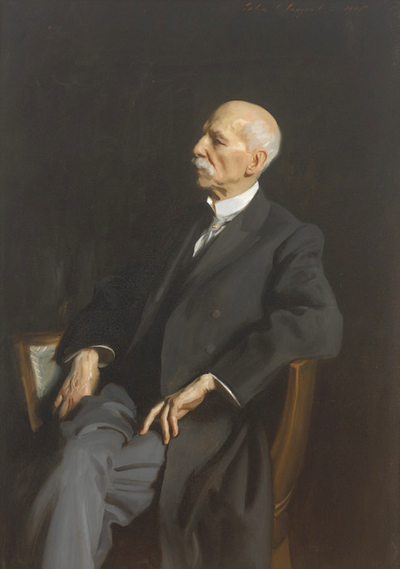 51. John Singer Sargent painted Manuel García (1805–1906), a professor at the Royal Academy of Music in London and the voice coach of legendary opera singers such as Jenny Lind, in celebration of his 100th birthday.
51. John Singer Sargent painted Manuel García (1805–1906), a professor at the Royal Academy of Music in London and the voice coach of legendary opera singers such as Jenny Lind, in celebration of his 100th birthday.
—The
Hired Frock-coat.
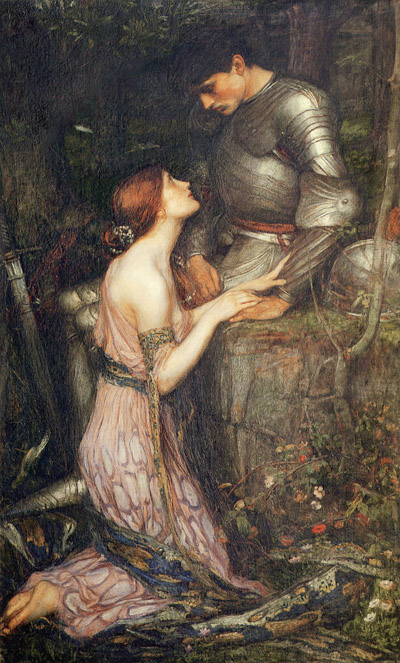 125. John W. Waterhouse (1849–1917) depicted Lamia and the Soldier.
125. John W. Waterhouse (1849–1917) depicted Lamia and the Soldier.
—Leap Year.
Lady proposing to her partner while sitting out at the Bachelors’
Fancy Dress Ball.
 182. Andrew Carrick Gow (1848–1920) painted “A Roman Triumph.”
182. Andrew Carrick Gow (1848–1920) painted “A Roman Triumph.”
—Return
of the Aston Villa team to Birmingham after the final tie.
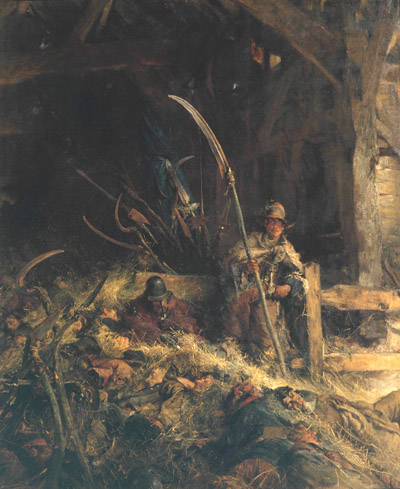 194. Edgar Bundy (1862–1922) depicted soldiers waking before the battle of Sedgemoor in 1685, at which James, Duke of Monmouth and Pretender to the throne of James II, was defeated.
194. Edgar Bundy (1862–1922) depicted soldiers waking before the battle of Sedgemoor in 1685, at which James, Duke of Monmouth and Pretender to the throne of James II, was defeated.
—Back
to the Land. City clerks sleeping in barn after haymaking.
279. Edward Matthew Hale’s “The Invaders”: “a snow scene in a wide valley with rocks at the opposite side red in the setting sun, and in the centre a motley horde of men and horses struggling in a long line through the snow; a kind of idea, apparently, of the invasions of the Goths; it is a suggestive and original work.” (The Builder, June 3, 1905) Wodehouse refers to a 1905 march to London by the bootmakers of Raunds, who were striking for not being paid at the negotiated rate for their handmade army boots. See this article for more.
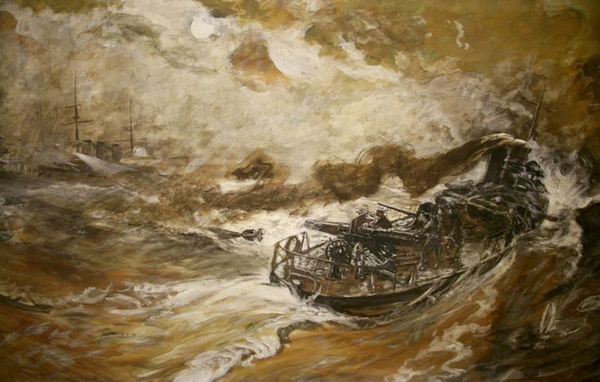
299. C. Napier Hemy (1841–1917) depicted a torpedo destroyer trying to approach a battleship at night being “betrayed by the moon.” Wodehouse refers to an incident in which Russian warships mistakenly fired on British fishing boats, discussed in a poem published earlier that year.
—Baltic
Fleet shooting torpedo-boat in mistake for trawler.
302.“Herkomer has a splendid portrait of W. A. Bell, Esq. The old man, with his smiling eyes, pointed white beard and general air of distinction, might have stood for a Spanish grandee before Velasquez. In our ungallant days he is painted in a picturesque waistcoat and riding breeches, hands on hips; but he stands so natural and so firmly planted one takes positive pleasure in the pose.” (Gabriel Powers in The Messenger, October 1905)
—‘Yes.
I know I look queer. They promised to send back that collar in
time, and it hasn’t come!’
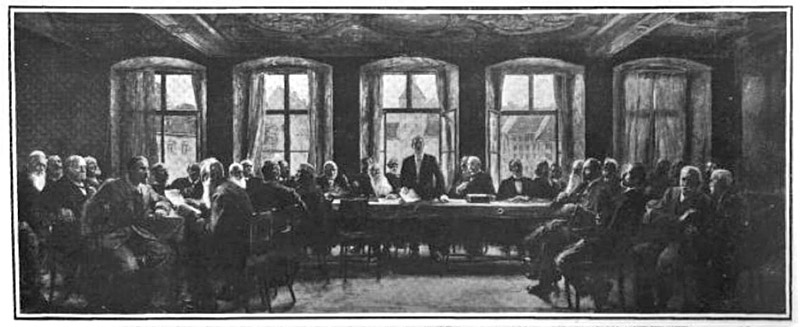 358. Herkomer’s Burghers of Landsberg, from a reproduction in the Sphere, May 6, 1905. The painting was 24 feet long!
358. Herkomer’s Burghers of Landsberg, from a reproduction in the Sphere, May 6, 1905. The painting was 24 feet long!
—The
Bump Supper. The President of the Rowing Club obliges with a song.
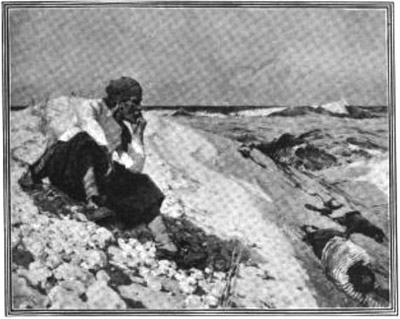 432. “ ‘Alone’
by C. M. Padday is a sad picture,
a shipwrecked sailor sitting on the sand with
bodies of two comrades close beside him, with
wreckage on the shore, and a sea such as is
found when a storm subsides. The man is
alone, evidently the only survivor of a ship-wrecked crew, and the pathos of it is increased
by the bright sunshine and the blue colour
of the water.” (The Building News, May 5, 1905)
432. “ ‘Alone’
by C. M. Padday is a sad picture,
a shipwrecked sailor sitting on the sand with
bodies of two comrades close beside him, with
wreckage on the shore, and a sea such as is
found when a storm subsides. The man is
alone, evidently the only survivor of a ship-wrecked crew, and the pathos of it is increased
by the bright sunshine and the blue colour
of the water.” (The Building News, May 5, 1905)
—The Tripper.
By the Silver Sea.
458. “Flora’s Bower,” Robert Christie. “This can hardly be the Roman Flora. The picture represents a number of partially-clothed and plain-featured young women trespassing amongst growing Rhododendrons; Flora (really a twentieth-century young girl) is entirely nude—one does not usually see the Roman Flora so portrayed. A boy with blue wings is descending head-first from the sky to salute Flora.” (Gardeners’ Chronicle, May 6, 1905)
—The
Ladies’ Swimming Race. Chairing the winner.
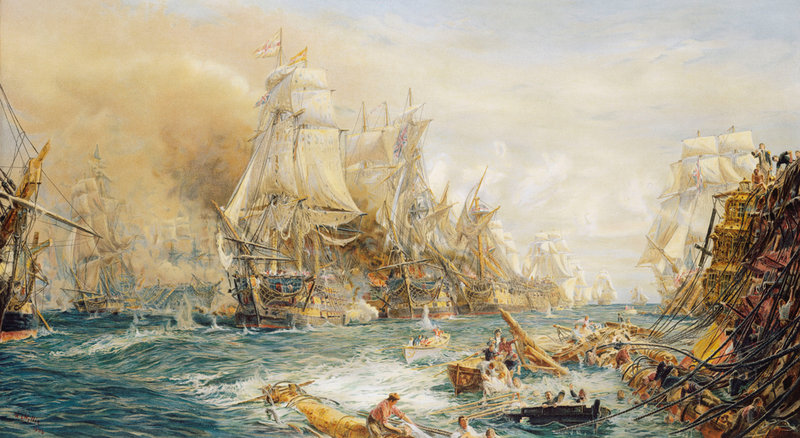 459. William Lionel Wyllie (1851–1931) painted the Battle of Trafalgar as it stood at 2:30 p.m. on October 21, 1805.
459. William Lionel Wyllie (1851–1931) painted the Battle of Trafalgar as it stood at 2:30 p.m. on October 21, 1805.
—Reception
of the Spanish and French fleets in 1805. (Old style. We do it differently in 1905.)
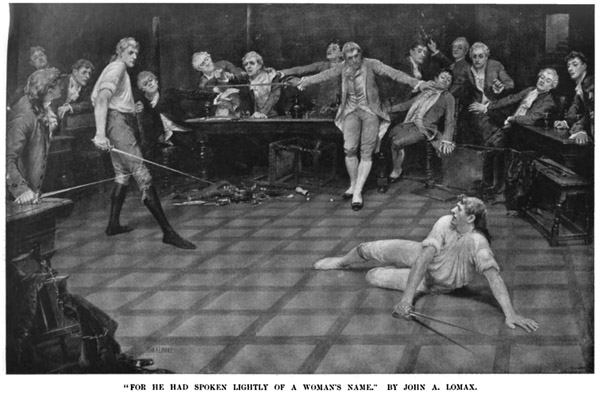 625. “For he had spoken lightly of a woman’s name” by John A. Lomax (1857–1923); image from Windsor Magazine, 1907.
625. “For he had spoken lightly of a woman’s name” by John A. Lomax (1857–1923); image from Windsor Magazine, 1907.
—The House of Commons on a Fiscal night.
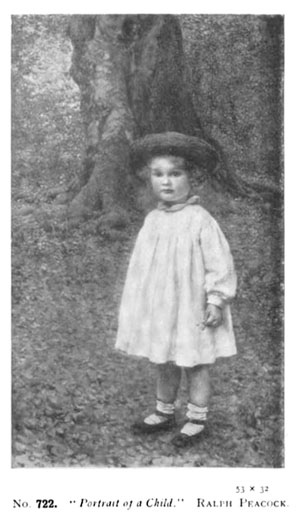 722. Wodehouse and his “By the Way” colleagues often poked fun at Churchill’s inexperience and impetuosity as a young Member of Parliament (first elected in 1900 at age 26).
722. Wodehouse and his “By the Way” colleagues often poked fun at Churchill’s inexperience and impetuosity as a young Member of Parliament (first elected in 1900 at age 26).
—Mr.
Winston Churchill, M.P.
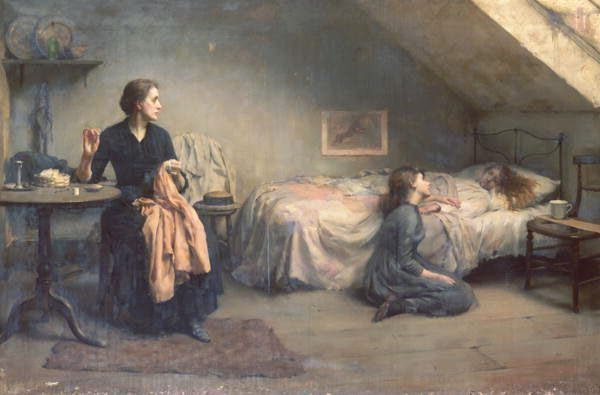 729. “The Widow” was one of many works by Thomas Benjamin Kennington (1856–1916) highlighting the pathos of the poor, widowed, and homeless inhabitants of London. I can find no image of the 1905 exhibition portrait, but at right is “Widowed and Fatherless” from 1888 to give an impression of his style.
729. “The Widow” was one of many works by Thomas Benjamin Kennington (1856–1916) highlighting the pathos of the poor, widowed, and homeless inhabitants of London. I can find no image of the 1905 exhibition portrait, but at right is “Widowed and Fatherless” from 1888 to give an impression of his style.
—Your
food will cost you more. [cf. the Parrot poems]
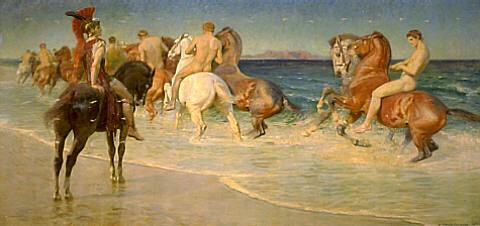 784. William Frank Calderon (1865–1943): “On the Sea-Beat Shore, Where Thracians Tame Wild Horses from Alexander Pope, Homer’s Iliad”
784. William Frank Calderon (1865–1943): “On the Sea-Beat Shore, Where Thracians Tame Wild Horses from Alexander Pope, Homer’s Iliad”
—The start for the Derby. Cicero leading.
970. “In the Water-Colour Room hangs a long-shaped picture, A Dream of the Sorrowful Way, by J. R. Wilmer, of large size considering the medium in which it is painted. The picture is crowded in every part with figures, and at first sight the monotony of a rather unpleasant yellow-brown colour discourages the eye. A closer examination shows that the artist has a real command of facial expression, and a power of imagining figures possessed of a great deal of character. In the middle of the composition is a purely symbolical rendering of Christ bearing the cross, surrounded by vast numbers of those who also travel upon the Sorrowful Way.” (Spectator, May 6, 1905)
—L.C.C.
Improvements. The Strand at midday; road up.
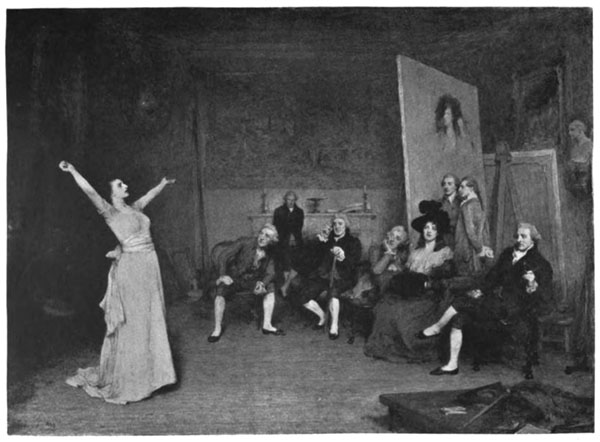 1316. The exhibited engraving by Frederick Huth follows the painting by W. Q. Orchardson, illustrated here.
1316. The exhibited engraving by Frederick Huth follows the painting by W. Q. Orchardson, illustrated here.
—Ju-jitsu. The challenge.
 Madame Eulalie’s Rare Plums
Madame Eulalie’s Rare Plums